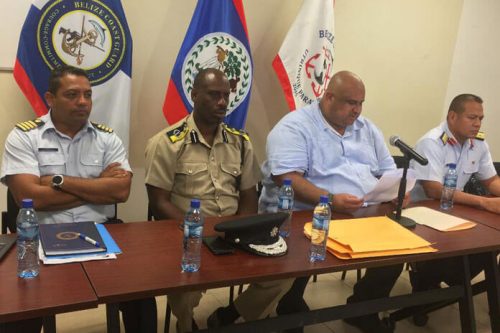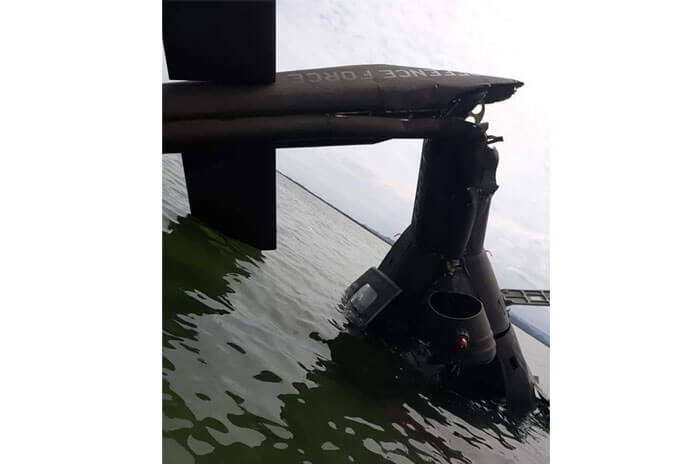BELIZE CITY, Tues. Mar. 10, 2020– The Ministry of National Security held a press briefing at the Belize Coast Guard Headquarters, where a preliminary report into the Belize Defence Force (BDF) helicopter crash on February 27 in which 4 soldiers died, was presented this afternoon by the Attorney General and Minister of Defence, Hon. Michael Peyrefitte.
Peyrefitte was joined at the head table by other senior members of the National Security Ministry, including Coast Guard Commander, Elton Bennett, who is one of the investigators of the accident; Chief of Defence Staff Admiral John Borland, Deputy Commissioner of Police Edward Broaster and BDF Brigadier General Steven Ortega.

Head table at press briefing: Coast Guard Commander, Elton Bennett; Deputy Commissioner of Police, Edward Broaster; Minister Michael Peyrefitte; Chief of Defence Staff, Admiral John Borland; and Brigadier General, Steven Ortega.
According to the findings of the report, which was prepared by the Honduran Air Force Accident Prevention and Investigation Board with the assistance of the Belize Civil Aviation Department, as well as representatives of the US and British governments, pilot error was to blame for the deadly crash which killed the four BDF soldiers in the helicopter.
After presenting a review of all the necessary technical aspects of the aircraft and finding that everything had performed as expected, the report said, “Based on the verifications made, it is preliminarily concluded that the airworthiness (condition) of the aircraft was not a factor for this accident.”
The report added, “The crew began a right turn with a descending vertical speed of one thousand feet per minute which possibly caused a spatial disorientation in the crew, since they were performing a night flight under unfavorable atmospheric conditions, without night vision goggles equipment and also flying over water.”
The report stated that both pilots had limited night flying experience. Major Baizar only had 4 hours of training in night-flying a UH-1H helicopter through coursework that he did in Jamaica, and none of the two pilots had experience in flying with night vision goggles, “since the BDF does not have the equipment.”
The helicopter engine will be sent to the manufacturer for further testing, the report said.
In its Recommendation to the BDF High Command, the Report advised that there should be no more night operations over water, without the aid of night vision goggles.
The report also recommended that in future operations there should be someone on the ground to maintain communications. If someone had survived the crash, that person would nonetheless have died due to the length of time that passed before there was a search and rescue mission in response to the incident. It took the BDF more than 24 hours before it realized that BDF12 UH-1H had not returned to base, following its deployment in the drug plane interdiction effort the day before.
At the Ministry of National Security’s first press conference on Friday, February 28, statements were made by the Minister of National Security and senior members of the national security apparatus that appear to be conflicting with the details that were provided at today’s press briefing.
Minister Peyrefitte narrated the timeline of the events leading to the discovery of the accident as follows: “On February 27th, 2020, at around 1:38 a.m., the Joint Intelligence and Operations Center (JIOC), which is a combination of BDF, Coast Guard and Police, made a request of General Ortega, which General Ortega conditionally approved, for a helicopter to assist in the operation which led to the seizure of a drug plane a few hours later.
“At around 1:45, seven minutes after that, JIOC calls Major Ramirez and tells him to get prepared for a mission as General Ortega had conditionally approved a mission for him to deploy a helicopter to assist the JIOC with an operation.
“At around 2:12 a.m., General Ortega calls Major Ramirez and asked him if the mission is a go. At 2:18 a.m., General Ortega calls JIOC to get a briefing on the mission and repeats his conditional approval as he explains to JIOC that it would be up to Major Ramirez to finally determine if they can fly the helicopter, based on the weather and other factors.
“At 2:22 a.m., General Ortega calls Major Ramirez and tells him that the mission is a go, provided that he, Major Ramirez, is satisfied that the proper conditions exist in order to safely fly and that in his, General Ortega’s view, the weather will not clear up until about 5:00 a.m.
“At around 3:17 a.m., Major Ramirez texted General Ortega and said, ‘Sir, weather di hold up. We’ll depart.’ It is important to note at this point, that at various times before February 27th, 2020, JIOC and General Ortega had requested air assistance from Major Ramirez and he refused to command a mission because of unfavorable conditions. This was never treated as insubordination, as it is accepted when it comes to flights that the Air Wing has the final say. It is also important to note at this point that once Major Ramirez, as commander of the Air Wing, had decided to accept a mission, then he is the one with the total discretion to pick the pilots and crew, as was the case here. At around 3:54 a.m., Major Ramirez signs out on the helicopter and crew and by around 4:07 a.m., the helicopter lifted off from the Williamson Base at Philip Goldson International Airport area.”
The Ministry of National Security has stated that the helicopter was a part of the interdiction effort that morning, but to date no specific information was provided as to the role that the helicopter played.
Not only that, but the preliminary report is now stating that the helicopter departed from its base at 4:07 a.m. and flew to the area where the drug plane was supposed to be landing.
The last communication with the helicopter that morning was around 4:38 a.m.
This is how Peyrefitte continued breaking down the time sequence: “Once the helicopter lifted off, then as per protocol Major Ramirez communicated directly with JIOC, who were the ones spearheading the mission. At 4:18 a.m. Major Ramirez messages JIOC…a series of messages are then exchanged between Major Ramirez and JIOC, which I cannot reveal for the purposes of National Security and the security of future operations. Major Ramirez messaged Major Velez of JIOC at around 4:33 a.m. and then Major Velez responded at around 4:38 a.m. saying ‘Great help, bredrin; thanks.’
“At this point, the specific purpose of the helicopter in the mission had been served and it was expected that the helicopter would return to base. That last text that Major Velez sends to Major Ramirez that says, ‘Great help, Bredrin, thanks’ only had one tick, indicating that in normal circumstances Major Ramirez did not receive that WhatsApp message.”

Major Adrian Ramirez, Commanding Officer of Air-Wing; Major Radford Baeza, Second-in-Command; Corporal Reynaldo Choco, and Corporal Yassir Mendez, deceased
During the first press briefing Peyrefitte had stated that it was not unusual for the helicopter to hover over the area of operations or land nearby. There was no mention that after it completed whatever role it played in the mission that it should have returned to base, as the Minister indicated today.
Major Ramirez did not respond to the last WhatsApp message, but that still did not set off alarm bells at Price Barracks until more than 24 hours later.
In their first press briefing, the Minister had stated that it was normal for the helicopter crew to not maintain radio communication, but at today’s briefing the media learned that there was no radio communication with the helicopter, but instead the operation was relying on WhatsApp messages, which, according to the Honduran who prepared the report, could have contributed to the disorientation of the pilot.
Reporters questioned Peyrefitte and Brigadier General Ortega about the use of Whatsapp messages on such a mission.
Peyrefitte was asked if the WhatsApp messages would be disclosed to the public, and, citing national security concerns, he said they would absolutely not be disclosed.

